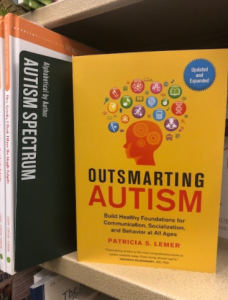Autism can significantly impact the way that a person experiences and interacts with the world around them —vision issues can make it even harder.
The Autism Prevalence Study (Sept 2018), determined that almost 2% of all children are affected by Autism Spectrum Disorder (ASD).
Here are our top 6 frequently asked questions about autism spectrum disorder and vision problems:
Q1: What is autism spectrum disorder?
Autism spectrum disorder (ASD) is a developmental disability that causes those affected to have difficulty with social cues, communication and behavioral norms.
ASD is diagnosed in more than 1 in 60 of all births.
People with ASD are neuro-divergent, meaning that their style of social interaction, communication and learning may differ significantly from their peers.
Autism is considered a spectrum, because the level to which a person is affected by the disorder varies widely. Thinking, learning and problem-solving abilities can range from gifted and talented to severely challenged.
Depending on where they are on the spectrum, a person with ASD may need help with even simple tasks in their daily lives, or may need little to no help..
Several learning and social conditions that used to be considered separately now fall under the umbrella of ASD: autistic disorder, Asperger syndrome and pervasive developmental disorder not otherwise specified (PDD-NOS).
Q2: Are vision problems easy to spot in people with ASD?
No.
The Journal of the American Association for Pediatric Ophthalmology and Strabismus found as recently as 2019, that it is very common for people with autism to have undetected vision problems.
This is because symptoms of vision issues and those of ASD can look very similar, causing confusion, and visual problems can go undetected and untreated as a result.
These vision problems can make life much harder, as they create difficulties processing and coping with what the person is seeing.
Common signs and behaviors that can signal vision issues include:
- Looking beyond/through objects
- Turning the head to use peripheral vision instead of central vision to look at objects
- Rolling eyes
- Poor eye contact
- Showing either little/no fear of heights or an excessive fear of heights
- Flapping fingers in front of eyes (known as visual stimming)
- Sensitivity to light
SEE RELATED: Vision and Autism (ASD)
For more information about ASD and vision issues, contact an eye doctor near you.
Q3: What does an eye doctor look for in an eye exam with someone with ASD?
During an eye exam with someone with ASD, the optometrist will look for common problems including:
1. Eye tracking problems
Eye tracking refers to the eyes’ ability for the eyes to accurately follow moving objects.
If a person with autism prefers to view objects by looking at them from the side rather than looking at them head-on, eye tracking issues may be to blame.
2. Binocular vision problems
A person with binocular vision (BV) issues will have difficulty with their eyes working together to collect visual information.
This causes different visual information to be sent from each eye to the brain, making it difficult to interpret and combine into a single image.
BV issues cause double/blurry vision, headaches and eye strain.
A common binocular vision issue associated with ASD is convergence insufficiency (CI).
This condition causes an inability of the eyes to converge together on an object close-up, making tasks such as reading or writing especially difficult. Headaches, blurry vision and difficulty focusing for long periods of time are common side effects of CI.
3. Eye movement disorders
Eye movement disorders make accurate and smooth unified movement of the eyes more difficult. This makes it hard for the eyes to gather consistent visual information for the brain to interpret.
The most common eye movement disorder in people with ASD is strabismus, a condition that causes the eyes to point in different directions.
The eye turns can happen all the time, or only intermittently, for instance when a person is tired.
Q4: What is vision therapy?
Vision therapy is a doctor-prescribed, evidence based treatment regimen aimed at strengthening the connection and coordination between the brain and the eyes.
Vision therapy includes both at-home and in-office eye exercises and normally takes about 4 to 6 months for the results to be fully realized.
The optometrist may choose to supplement the exercises with other vision therapy aids, including balance boards, ambient prism lenses and computer-based games.
Q5: Can vision therapy help with vision problems in people with ASD?
Yes.
The eye doctor will evaluate the specific needs of the person participating in the vision therapy and customize the therapy regimen according to these needs.
For a person with autism, vision therapy will likely focus on helping them understand and interact with the world around them more comfortably by improving their visual processing skills.
Once these skills are mastered, the world may seem more manageable, reducing anxiety and encouraging smoother social interactions and communication.
Q6: What are yoked or ambient prism lenses?
Visual-spatial problems, such as objects or people seeming to move even when at rest, can cause confusion and anxiety in those with ASD, leading to common coping mechanisms such as poor eye contact.
Prism lenses subtly move objects and images to where the brain thinks the image should appear. This can considerably boost a person’s sense of physical safety and comfort while reducing anxiety and sensory overload.
Depending on the eye doctor’s recommendation these lenses can be worn every day or only as part of vision therapy exercises.
Using ambient or yoked prism lenses as instructed by your optometrist can significantly improve vision and help with vision-related ASD symptoms.
LEARN MORE: Vision for Special Needs
If your child has ASD, schedule an appointment with an eye doctor for a comprehensive eye exam.
The Autism Prevalence Study (Sept 2018), determined that almost 2% of all children are affected by Autism Spectrum Disorder (ASD).
Here are our top 6 frequently asked questions about ASD and vision problems.









